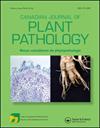加拿大安大略洋葱上鳞茎茎的杂草寄主及冬季存活
IF 1.5
4区 农林科学
Q3 PLANT SCIENCES
引用次数: 1
摘要
摘要洋葱叶枯病是洋葱(Allium cepa)的一种重要病害,是由真菌病原体泡叶枯病引起的。这种病原体也会导致多种其他植物物种的疾病。洋葱的SLB主要通过施用杀菌剂来控制。初级接种物的来源以及水疱镰刀菌是否能在该地区越冬尚不清楚。接种和随后从洋葱田附近常见杂草中重新分离病原体表明,这些杂草中的许多都是囊泡孢杆菌的宿主。红根猪草(Amaranthus retroflexus)、黄果菊(Cyperus esculentus)、黄色水芹(Rorippa palustris)、多年生播种蓟(Sonchus arvensis)和马齿苋(Portulaca oleracea)被鉴定为囊泡菌的新寄主,牛蓟(Cirsium vulgare)被确认为寄主。春季死杂草残留物上的孢子可能是相邻洋葱田感染的主要接种物来源。此外,一项对埋在土壤中或留在土壤表面的洋葱受感染叶片中病原体存活的研究表明,水疱菌可以在受感染的洋葱叶渣中越冬,并在早春产生假古猿和子囊孢子。这些结论支持了现有的管理建议,即埋葬或清除洋葱碎片以及管理洋葱田及其周围的杂草。本文章由计算机程序翻译,如有差异,请以英文原文为准。
Weed hosts and winter survival of Stemphylium vesicarium on onion in Ontario, Canada
Abstract Stemphylium leaf blight (SLB), caused by the fungal pathogen Stemphylium vesicarium, is an important disease of onion (Allium cepa). This pathogen also causes disease on a wide range of other plant species. SLB on onion is managed primarily through fungicide application. The source of primary inoculum and whether S. vesicarium can overwinter in the region were not known. Inoculation and subsequent re-isolation of the pathogen from common weed species present near onion fields demonstrated that many of these weedy species are hosts of S. vesicarium. Redroot pigweed (Amaranthus retroflexus), yellow nutsedge (Cyperus esculentus), yellow marshcress (Rorippa palustris), perennial sow thistle (Sonchus arvensis) and purslane (Portulaca oleracea) were identified as new hosts of S. vesicarium and bull thistle (Cirsium vulgare) was confirmed as a host. Sporulation on dead weed residue in spring may be a source of primary inoculum for infection of adjacent onion fields. Also, a study of pathogen survival in infected leaf pieces of onion buried in soil or left at the soil surface demonstrated that S. vesicarium can overwinter in infected onion leaf residue and produce pseudothecia and ascospores in early spring. These conclusions support existing management recommendations for the burial or removal of onion debris and managing weeds in and around onion fields.
求助全文
通过发布文献求助,成功后即可免费获取论文全文。
去求助
来源期刊
CiteScore
4.50
自引率
5.00%
发文量
56
审稿时长
6-12 weeks
期刊介绍:
Canadian Journal of Plant Pathology is an international journal which publishes the results of scientific research and other information relevant to the discipline of plant pathology as review papers, research articles, notes and disease reports. Papers may be submitted in English or French and are subject to peer review. Research articles and notes include original research that contributes to the science of plant pathology or to the practice of plant pathology, including the diagnosis, estimation, prevention, and control of plant diseases. Notes are generally shorter in length and include more concise research results. Disease reports are brief, previously unpublished accounts of diseases occurring on a new host or geographic region. Review papers include mini-reviews, descriptions of emerging technologies, and full reviews on a topic of interest to readers, including symposium papers. These papers will be highlighted in each issue of the journal and require prior discussion with the Editor-in-Chief prior to submission.

 求助内容:
求助内容: 应助结果提醒方式:
应助结果提醒方式:


